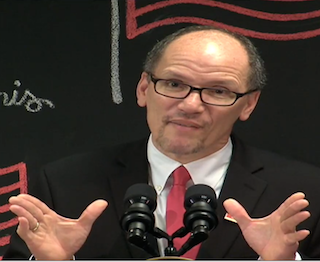
The new overtime rule finalized by the Department of Labor on Wednesday “is not only the right thing to do; it’s good business,” Vice President Joe Biden told the crowd gathered at a press conference in Columbus, OH, where government officials discussed the changes.
Senior living trade associations, with members in many states and cities already facing proposed or effective minimum wage increases, do not agree with Biden’s assessment, however, based on comments representatives made to McKnight’s Senior Living.
The final overtime rule, which will become effective Dec. 1, doubles the salary threshold — from $23,660 to $47,476 per year — under which most salaried workers will be guaranteed overtime pay when they work more than 40 hours per week, and that threshold will be updated automatically every three years. Under the changes, 4.2 million additional workers not currently eligible for overtime under federal law will become eligible. The government forecasts that the rule will increase wages by $12 billion over the next 10 years.
‘Not inconsequential’
“We don’t support it,” said Argentum President and CEO James Balda, adding that he anticipates that the rule will face legal challenges. “From a cost perspective, it’s not going to be inconsequential,” he added.
The organization, as well as the American Health Care Association and National Center for Assisted Living, LeadingAge and the American Seniors Housing Association, were some of the groups that commented on the rule to the Labor Department in 2015. At the time, Argentum, with ASHA, asked that the rule be withdrawn; AHCA/NCAL asked that it not be applied to assisted living and long-term and post-acute care operators; and LeadingAge recommended scaling back the increase in the salary test to $35,000 in 2016 dollars and that other changes be made as well.
In a fact sheet posted online, the White House said that the government heard employers’ concerns that a revised duties test for employees who perform certain executive, administrative or professional duties would be difficult and expensive to implement, so the current duties test will remain in place. Also, for the first time, employers will be able to count bonuses and commissions toward as much as 10% of the salary threshold.
But the final rule still is problematic, trade group representatives said.
Because assisted living is predominantly a private-pay industry, operators will have to pass costs on to consumers, said Maribeth Bersani, Argentum’s chief operating officer and senior vice president of public policy. “We can’t cut back on care,” she said.
The rule, although well-intentioned, should have accounted for geographic differences in cost of living, Bersani said, noting that the change will affect providers in some areas more so than others. The salary threshold was based on the 40th percentile of earnings for full-time workers in the South, currently the lowest-income Census region.
An unanticipated consequence of the rule, Bersani added, might be lower morale among some employees who are exempt under the current rule but will not be when the new rule goes into effect. “They’re going to feel like they’ve been demoted even though the weren’t,” she said.
Some Argentum members probably will increase employee salaries so that they meet the threshold, Bersani predicted, whereas others will examine their staffing patterns to see where they can make changes.
‘Profound effect’
Jennifer Hilliard, director of philanthropy and legal affairs for LeadingAge, said the rule will have a “profound effect” on members.
Although the organization agreed with the Labor Department that the salary threshold needed to be updated, she said, “without corresponding increases in federal and state funding for the services LeadingAge members provide, many will be hard-pressed either to raise salaries to meet the new thresholds or absorb the additional overtime costs, which is why LeadingAge advocated for a more modest increase in the salary threshold.”
Hilliard said she anticipates that many members either will place strict limits on their employees’ ability to earn overtime pay or will adjust their base rate downward with the expectation that staff members will work a certain amount of overtime to net the same salary they were making previously. “Neither of these options produces a net benefit to the employee in terms of increased wages, and the latter option could result in a net decrease in pay if the employee does not work the anticipated overtime hours,” she said. “The burden of compensating for limited hours would fall squarely on employees who remain qualified for the white-collar exemption, thereby frustrating one of the stated purposes of the rule to prevent overwork.”
‘Drastic’
Greg Crist, AHCA/NCAL’s senior vice president of public affairs, called the rule “drastic.”
“The long hours put in by dedicated caregivers in long-term and post-acute care centers do not go unnoticed, but we had hoped for more incremental changes to the overtime regulations,” he said.
Assisted living and skilled nursing providers are not receiving relief similar to providers of intellectual disability and developmental disability care, Crist noted, despite the fact that most residents/patients rely on Medicaid and Medicare. “With already thin margins and stringent staffing requirements, we will be limited in our ability to make changes to their operations,” he said. “We worry today’s announcement may indirectly result in limiting access to care for seniors and individuals with disabilities as providers fight to ensure their doors remain open.”
 Technical guidance coming
Technical guidance coming
In remarks during the Wednesday press conference, Secretary of Labor Thomas E. Perez (pictured) said that his department will be issuing technical guidance to assist employers in implementing the rule.
“There is no one-size-fits-all solution for compliance with this rule,” he said. “We’re going to continue to work with employers to ensure that when the rule goes into effect on Dec. 1, they have a very, very flexible and viable road map for compliance.”
Overtime pay requirements were first put into place by the Fair Labor Standards Act of 1938. They were last updated in 2004.
In 1975, 62% of workers qualified for overtime based on their salaries, Biden told those at the press conference, adding that, today, 7% of workers qualify. During the presidency of Ronald Reagan, he added, CEO pay averaged 32% more than employee pay, whereas today, it averages 380% of employee pay.
Calling restoring and expanding the middle class “the defining issue of our time,” Biden said that the new overtime rule is at the heart of that issue. “The middle class is what built this country. That’s not hyperbole,” he said. “It’s what built this country. When the middle class does well, the wealthy do very, very well, and the poor have some hope.”
Perez said the benefits workers will see from the new rule include more money, more free time and clarity about their rights.
Additional information about the rule is posted on the Labor Department website.



